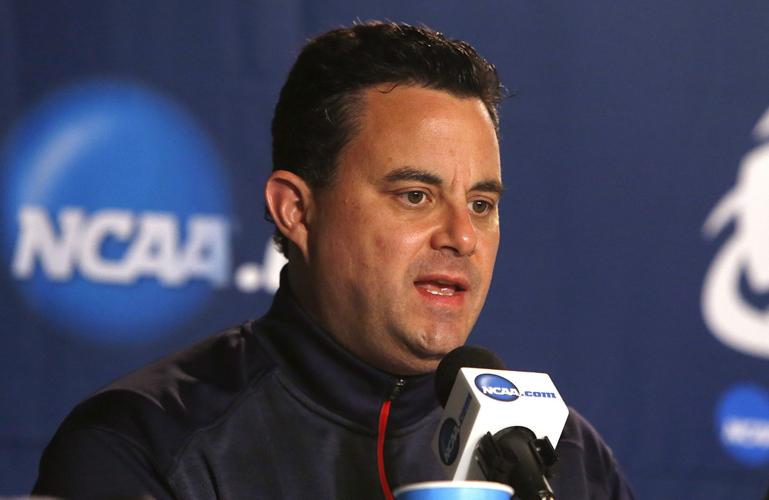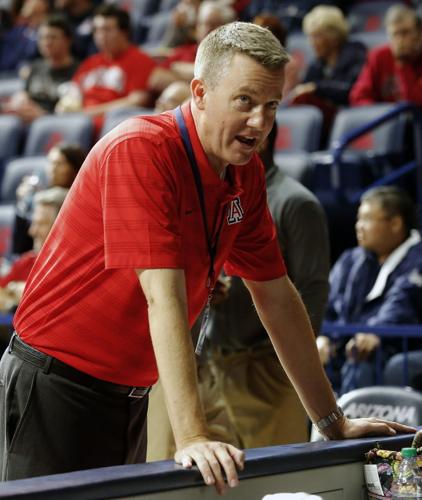When the Arizona Board of Regents voted to approve a multimillion-dollar retention plan for UA’s three highest-profile athletic department employees in June 2014, it was at no cost of their own.
House money, in a sense.
An unnamed UA benefactor had donated nearly $18 million worth of stock to fund an unusual plan that would annually spin off significant six-figure dollar amounts of stock yields for the school while potentially giving UA athletic director Greg Byrne, football coach Rich Rodriguez and basketball coach Sean Miller incentive to stick around until 2022.
Today, the Regents will vote on whether to pass that money along even faster, in a move that could cost UA about $1 million in forfeited stock income while allowing Byrne and Miller to cash out two years earlier. A similarly accelerated plan for Rodriguez was approved in June.
A “yes” vote would also give Miller and Byrne one-year contract extensions to 2020, matching the extension Rodriguez received in June.
Although the move is clearly a benefit to Miller and Byrne, motivation for the school’s proposal is unclear. A request for comment from UA president Ann Weaver Hart was unsuccessful, while Byrne said he couldn’t comment before the Regents voted.
In addition, a spokesman for the company whose shares were donated said the benefactor did not want to comment on the proposed change because it was “university business.”
Here’s a look at how the deal is evolving:
The original plan
The benefactor donated 500,000 shares in a publicly traded Master Limited Partnership (identified as Western Refining Logistics LP by the Financial Times), with 175,000 shares each allotted for Miller and Rodriguez, 100,000 for Byrne and 50,000 to be used at the school’s discretion.
Since the MLP shares were worth $35.36 at the time of the deal’s structure in May 2014, that meant Miller and Rodriguez had $6.19 million worth of stock set aside for them and Byrne had $3.54 million. However, the stock price has slipped 34 percent since then.
Each of the three employees were entitled to the entire amount of their shares if they did not voluntarily leave before 2022. They could collect their full shares if fired without cause after four years, or receive a prorated amount if fired without cause before four years.
Rodriguez’s new deal
The Regents voted in June to allow Rodriguez to receive 25 percent of his stock outright on March 15, 2016 — a more immediate incentive, but one that could all but lock him in for the 2016-17 season, since football head coaching hires are typically made before mid-March.
Rodriguez can collect another 25 percent in 2018 and the final 50 percent in 2020. His base salary also rose from $1.6 million to $1.775 million this season while his bonus incentives decreased. His contract was also extended through 2020.
Miller’s proposed deal
Miller was initially scheduled to have a similar change to his retention plan at the June 2015 Regents meeting but the proposal was withdrawn because of what Byrne called a technical issue.
The proposal initially to be submitted in June said Miller could collect his vested amount if he left UA “for any reason,” and the new one says he won’t get anything if he “voluntarily terminates his employment or if he is terminated for cause for a reason other than disability or death” before 2020.
Miller can collect his vested amount before 2020, however, if he is fired without cause or leaves because of a “substantial physical or mental incapacity or death.” And instead of waiting until 2018 to be fully vested, Miller would be 75 percent vested as of today’s expected approval, and fully vested on June 1, 2017 (again, with a late date that would likely lock Miller in for 2017-18).
Miller will also receive a $100,000 raise in his extended contract year of 2019-20. He has $100,000 salary escalators in all but one season on his remaining contract. For this season, Miller is guaranteed $1.4 million in base pay from the UA, plus $700,000 for peripheral duties and about $400,000 total from Nike and IMG for a total package of $2.5 million plus bonuses. His total package would be $2.8 million plus bonuses in the final year of 2019-20.
Byrne’s proposed deal
Byrne will have the same vesting schedule as Miller, while his salary will increase $25,000 to $750,000 in 2019-20. He is scheduled to earn $650,000 for the 2015-16 school year.
At the same time, some of Byrne’s incentives will change. Instead of being rewarded for the student graduation rate in relation to the overall student graduation rate — the proposal said there is “no valid comparative data” for general students — Byrne instead can now earn a bonus based on UA’s multi-year Academic Progress Rates.
If all UA teams have 950 or higher APRs, Byrne can earn a bonus of one week of his base pay ($12,500 this year). He’ll get two weeks’ bonus if the APRs are 975 or higher and three weeks if they are all a perfect 1,000.
In addition, the proposal would lower the bonus thresholds for finishes in the Directors’ Cup, which measures all of a department’s teams against the rest of Division I.
Byrne will get a bonus of one week’s salary if UA finishes 16-25 (previously UA had to be in the 6-10 range), two weeks if it finishes 2-15 (previously 2-5) and four weeks’ bonus pay if UA finishes first. UA was 36th in the 2014-15 standings and 26th in 2013-14.
“The change is ... to make this category more realistic given that UA competes against many programs located in larger markets and that have significantly greater resources,” the proposal stated.
Proposals for both Miller and Byrne note that their compensation is paid entirely with funds generated by the athletic department.
The stock’s value
As of Wednesday’s market close, the donated Master Limited Partnership shares were worth $23.41, a drop of 34 percent since the plan was drawn up in May 2014. That means the coaches’ shares are worth $4.1 million and Byrne’s is worth $2.3 million.
However, the MLP is currently yielding about 5.9 percent annually. That rate suggests UA would earn about $600,000 in each year it remained in control of the 450,000 shares set aside for Rodriguez, Miller and Byrne. So by giving the stock back to them two years earlier, UA could lose over $1 million in forfeited yield.
UA-funded retention plans
All three employees are also nearing payouts for separate, university-funded retention plans.
Miller will receive $2.1 million if he stays through the end of the 2015-16 season, with UA having set aside $300,000 for each year he has coached the Wildcats since arriving in 2009, while Byrne and Rodriguez will each earn an extra $500,000 if they stay until 2016.





